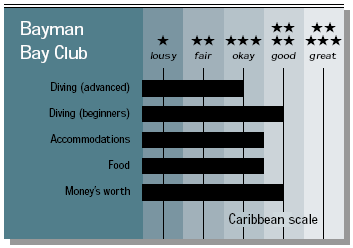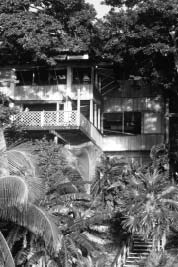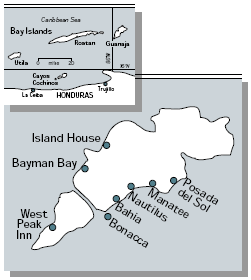Bayman Bay Club, GuanajaContents of this Issue: Bargain Diving: A Caribbean Sampler Great Whites Winter in Florida DEMA: BOBS, Yes; No Bubbles, No Editorial Office: Ben Davison Publisher and Editor Undercurrent 3020 Bridgeway, Suite 102 Sausalito, CA 94965 Easy, cheap, tropical diving from the March, 1997 issue of Undercurrent
Dear Fellow Diver, Its croak was low, guttural. I dropped down closer to the reef. I could hear it but I couldn't see it. I moved along the reef wall, flashing my light into the crevices, poking around for the creatures of the night. Just a few feet further along the reef, I heard it again -- a croak so low I could feel it resonate in my chest. This time I homed in on the sound with the beam of my dive light and gazed upon the source: a frilly, fleshy-tabbed toadfish. These grotesque creatures weree verywhere, on every dive, day or night. It was the only species that was abundant on this trip to the Bay Islands of Honduras -- but fortunately, there's more to a dive trip than bountiful fish. Swiss Family Robinson Style
I'd come to the Honduran Bay Islands for reasons no more compelling than the single day it takes to get here and the reasonable rates in a time of dwindling diving bargains. In other words, it's easy, cheap, and tropical, and it's diving. The Bay Islands, like the Honduran mainland and most of Central America, are mountainous and mostly shrouded by dense jungle forest interspersed with outcroppings of spiny rock and sparse trees. Rounding the point of land and entering into the bay fronting the Bayman Bay Club offers a picture postcard greeting to island living in an idyllic setting. As we alighted at the dock, our boatman advised us to carry only what we might want in the next five minutes. "We'll take everything to your room," he said, "and, anyway, there are about a hundred steps to the very top you'll be real familiar with by the end of the week." He was right. It was something like half a dozen daily bursts on the Stairmaster, only a lot more enjoyable (all dive gear is conveniently stored in a building down on the dock). I've never used an exercise machine that got me to or from a dive boat.
The Club itself is a loose collection of 15 or so rustic cabins unobtrusively scattered along the water's edge and up the mountainside. From the water, some of the cabins are nearly hidden from view, but you can always see the ocean from the cabins. Boardwalks and paved paths with other stairways weave through the complex. The property is, in effect, a maintained but unspoiled jungle that seems totally unattended and natural -- until you happen to wander off somewhere into the surrounding real jungle. The "room at the top of the stairs" is the Bayman Bay clubhouse -- the nerve center of the operation. The multilevel, open-air complex houses kitchen, dining facilities, bar, TV, library, pool table, and, in a "secret" cupola at the very top, a solitary hammock. An adjacent gift shop contains the usual fare plus some native art and a variety of bug juices to counter the renowned Bay Island sand flies. The managers, Eli and Don Pearly, are Americans
with about six months in residence. I snapped awake to the large Chinese gong that announces meals -- every one of which is a buffet that's both tasty and varied. The variety is, in fact, somewhat startling at times -- as in tortillas and refried beans next to French toast. No matter. There are always options for finicky eaters, such as fresh fruits and vegetables from the fertile valleys of the mainland. Views of ocean and jungle, complete with flights of forktailed emerald hummingbirds humming over your shoulder, accompany every meal. The dive routine at Bayman Bay, as explained when I booked the trip, was two a day: one in the morning and one in the afternoon, with one night dive some time during the week. Why burn up the entire day for two dives? Bayman Bay saw it that way too, for in practice we made two morning dives, either a two-tank dive or a return to the dock for a second tank, and an easy surface interval. However, I was told Bayman would soon go to three dives a day. The second week of December was slack, a time owners hate and customers love. The greatest number of divers we had was eight, but more often we were no more than five. Afternoons were a time to snooze, read, hike, kayak, snorkel, or shore dive. The shore diving is not too bad and you can go whenever you like, day or night. Wet and Not So Wild Some dive sites around Guanaja I'll remember, and some I'll soon forget.
Visibility never exceeded 40 feet during my week, but for the better dives, that was passable. Bayman is on the northwest side, but the canal dug some years ago makes it easy to dive both sides of the island. Before the canal, if the winds were bad on your side, you were more or less stuck. Better southeast-side dives include Jim's Silverlode, a deep wall dive that returns through a tunnel filled with silversides to shallower coral beds. A diver-conditioned moray of sturdy proportions spends some time there. As we emerged from the tunnel, my buddy turned toward me and pointed to my feet, where I met the jolly green giant swimming between my legs from behind and up into my face mask. He was nothing but friendly, but my buddy promptly covered her wedding ring lest a greening friendship turn to an ugly shade of red. The larger fish I had seen here a few years ago were not present, but it's still a fair dive. A few trained groupers are still here, and some smaller fish, but nothing to fill up your dance card. The Jado Trader, a drug ship hauled out and sunk at a 110 feet or so, also sports a resident eel and some groupers and margate. Like a few other wrecks I've been on, there's not a lot to study otherwise. Just say I went for the hull of it.
On the northwest side, Black Rock Canyon is memorable for its geologic formations. I found myself imagining being in a flooded canyon in the American Southwest. Sheer walls reach nearly to the surface from the sandy bottom some 60 feet below, honeycombed with tunnels, including one rather long and sometimes tight traverse that is not for the claustrophobic. The divemaster mentioned a tunnel as part of the dive plan, but didn't elaborate -- an omission that, after the fact, a couple of divers felt was inexcusable. The dive following, known as Fantasy Reef, was unquestionably our "fishiest" dive. We saw more small fish and reef critters of more different kinds than on the rest of the week's dives combined -- schools of chromis, a number of indigo hamlets, several varieties of parrots and angels, rock beauties, trunkfish, wrasses, blennies, gobis, coral shrimp, tube worms, and so on. But it was remarkable only by comparison with the scarcity of fish elsewhere. One thing about Guanaja diving is certain: you won't confuse your next dive with your last dive. On one dive you may see a bottom so covered with plate coral it looks like a landslide grown over with gorgonia. On the next you might find yourself finning through tight coral canyons and tall pillar coral; the one after that, poking in crevices and overhangs along the sandy bottom with a yawning rock canyon looming above.
Listen Up, Pay Attention, Then Do What You Want The dive boat, the Nimitz, is old but well maintained and seaworthy. It was the only dive boat I saw, though I understand the resort has two. A hard cover over half the boat is for sunning topside and shade below. Nimitz is set up for maybe 25 or 30 tanks, and I would devoutly hate to be on that boat (for that matter, any thirty-diver boat) with a full complement; space between tank mounts is about as thin as a sand dollar. But I found the Nimitz a comfortable dive boat. For entry, there are couple of spots, port and starboard, where you can do an easy back roll. Or you can enter off the rear dive platform, which is also for reboarding -- take off your gear in the water, kick, pull yourself up and turn around to land on your butt, or flounder aboard like a puppy dog. There is, by the way, a freshwater camera barrel on board. There's also DAN oxygen, along with signs proclaiming a staff trained in its use. Dockside, there's a freshwater rinse tank and convenient storage for your gear. Lowell Forbes and Eddie Carter were our principal dive crew for the week, alternating days as boat captain and divemaster. The dive staff was competent enough, but given to unduly restrictive dive plans: how does 80 feet for 20 minutes or 40 feet for 30 minutes grab you in an operation where they expect divers to use computers? When I dive, I normally put on layers like Nanook of the North and still freeze, but the water was a warm 80 degrees and, for a change, I wasn't in any hurry to get back, especially with 1,800 psi left in the bottle. Several of us, including me, stretched our dives and dived our computers. I heard no admonitions or complaints from the dive staff, but it was clear that they preferred to keep it as short as possible. In Essence
My feelings about the diving at Guanaja are ambivalent. Rarely will you hear about sightings of anything larger than an occasional nurse shark, medium-sized sting ray, or big green moray. And although that isn't unusual for a lot of dive spots, the paucity of smaller fish seems odd. Here you are, diving in a protected marine park over some of the Caribbean's lushest, healthiest, and most diverse coral reefs, and you'd think it would be an endless fishbowl. The flip side is the great variety of underwater topography and good hard and soft corals, coupled with a place to kick back for a week and soak up creature comforts in a beautiful Michener-type setting that's affordable and thoroughly enjoyable. Just one thing, though. It's okay to slap the bugs, but it's bad form to swat the hummingbirds. And don't eat the toadfish. C. J.
|

I want to get all the stories! Tell me how I can become an Undercurrent Online Member and get online access to all the articles of Undercurrent as well as thousands of first hand reports on dive operations world-wide
| Home | Online Members Area | My Account |
Login
|
Join
|
| Travel Index |
Dive Resort & Liveaboard Reviews
|
Featured Reports
|
Recent
Issues
|
Back Issues
|
|
Dive Gear
Index
|
Health/Safety Index
|
Environment & Misc.
Index
|
Seasonal Planner
|
Blogs
|
Free Articles
|
Book Picks
|
News
|
|
Special Offers
|
RSS
|
FAQ
|
About Us
|
Contact Us
|
Links
|
3020 Bridgeway, Ste 102, Sausalito, Ca 94965
All rights reserved.

 A faded sign and a forlorn collection of weather-beaten
timbers pointing skyward bade us "Welcome to the Future Home of
Guanaja Municipal Airport." A clutch of eager young hands grabbed
for our luggage as it was dragged off the air-weary Otter and
hefted it down the embankment along the dock to the small boat
that would ferry us to Bayman Bay Club, 15 minutes distant.
A faded sign and a forlorn collection of weather-beaten
timbers pointing skyward bade us "Welcome to the Future Home of
Guanaja Municipal Airport." A clutch of eager young hands grabbed
for our luggage as it was dragged off the air-weary Otter and
hefted it down the embankment along the dock to the small boat
that would ferry us to Bayman Bay Club, 15 minutes distant.  With her young
local assistant, Lisa Moore, Eli did the check-in
honors. It was shortly before sundown, and after
giving us a synopsis on where everything was and
when everything would happen, Eli whisked us off to
our digs. My place was large and airy, a totally
screened cabin with overhead fan, king-sized bed,
chairs, a practical work-surface table, and an ample
bath with roomy shower and demand hot water system.
An open porch afforded more chairs and a hammock.
Casual living in a jungle tree house -- not bad. I
watched a picture-perfect sunset and dozed in my
hammock.
With her young
local assistant, Lisa Moore, Eli did the check-in
honors. It was shortly before sundown, and after
giving us a synopsis on where everything was and
when everything would happen, Eli whisked us off to
our digs. My place was large and airy, a totally
screened cabin with overhead fan, king-sized bed,
chairs, a practical work-surface table, and an ample
bath with roomy shower and demand hot water system.
An open porch afforded more chairs and a hammock.
Casual living in a jungle tree house -- not bad. I
watched a picture-perfect sunset and dozed in my
hammock. 
